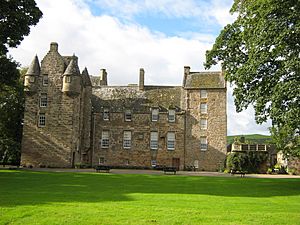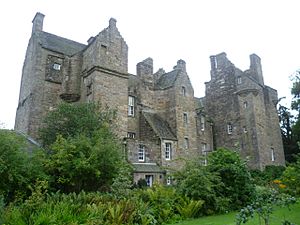Kellie Castle facts for kids
Kellie Castle is a historic castle located near the village of Arncroach in Fife, Scotland. It sits close to a large hill called Kellie Law. This amazing castle is about 4 kilometers (2.5 miles) north of Pittenweem, in a part of Fife known as the East Neuk.
Contents
A Look Back: Early History of Kellie Castle
The first mentions of Kellie Castle date back to 1150. It appeared in an important document, called a charter, from King David I. The very first owner we know of was Robert of London. He was the son of King William the Lion.
From Siwards to Oliphants
By 1266, Kellie Castle belonged to the Siward family. They came from Northumbria and had helped King Malcolm Canmore defeat Macbeth. However, the Siwards supported England during the Scottish Wars of Independence (1296-1328). Because of this, Sir Richard Siward lost his lands in Scotland after the Battle of Bannockburn. But his daughter, Helena Siward, known as "Lady Kellie," was allowed to keep Kellie. None of the buildings from their time are still standing today.
Around 1360, Helena gave Kellie to her relative, Walter Olifard (or Oliphant). He was married to Elizabeth, a daughter of Robert the Bruce. This began a long period of 250 years where the Oliphant family owned the castle.
The Erskine Family and Royal Visits
In 1613, Sir Thomas Erskine bought Kellie Castle. He was famous for saving the life of King James VI during a plot called the Gowrie Conspiracy. King James VI visited Kellie Castle in 1617. This was his only visit to Scotland after he also became King of England. In 1619, the King made Erskine the Earl of Kellie.
It's thought that the ceiling in what is now the library was decorated for King James's visit. This room might have been the first in Scotland to use plaster decorations in the "London style." This was a new trend, different from the painted wooden ceilings popular at the time. The ceiling shows the date "1617" and the initials "T V F." These stand for Thomas Viscount Fenton, a title King James gave to Thomas Erskine in 1606.
Castle Design and Changes Over Time
Kellie Castle started as a simple tower house. The oldest part is the lower section of the northwest tower, built around 1360. Some people say this part of the castle is haunted.
In 1573, the 4th Lord Oliphant built a new tower to the east. He likely built this east tower for his wife, Margaret, to live in if he passed away. Between 1573 and 1606, these two towers were connected by a new section. Another tower was added to the southwest, giving the castle its "T" shape that you see today.
The castle is a great example of Scots Baronial architecture. This style features a mix of interesting gables (the triangular parts of walls), corbelled towers (towers with stone supports sticking out), and many chimneys.
For much of the 1600s, the Erskines of Dirleton owned the castle.
Bringing Kellie Castle Back to Life
In 1829, the 10th Earl of Kellie passed away. The castle was then left empty and its contents were sold at a public auction in 1830. For many years, Kellie Castle was abandoned and unused.
The Lorimer Family's Restoration
In 1878, James Lorimer rented the castle. He was a professor at Edinburgh University. His son, Sir Robert Lorimer, became a very famous Scottish architect. The Lorimer family began to restore the castle. They first used it as a holiday home, but it soon became their main family residence.
Robert Lorimer played a huge part in the restoration. He helped bring back the beautiful plaster ceilings, painted panelling, and furniture. Robert Lorimer's architectural work can be seen all over the world. At Kellie, he designed the doocot (a pigeon house) and a garden house. He also helped restore the castle's garden with his sister, Caroline-Louise.
After Professor Lorimer passed away in 1890, his wife Hannah continued the tenancy. Robert Lorimer began making changes to the castle in 1900, building the doocot and garden house.
When Hannah passed away in 1916, their son, John Henry Lorimer, a famous Scottish painter, took over the tenancy. Robert then started restoring the main house, something Hannah had not wanted earlier.
A New Chapter for the Castle
After John Henry's death in 1936, the castle became empty again. However, in 1936, Sir Robert's son, the sculptor Hew Lorimer, and his wife Mary, renewed the Lorimer family's connection to the castle. Hew and Mary Lorimer bought the castle in 1948. Hew owned it until 1970. He continued to live in part of the castle and used the stable building as his art studio until 1990.
Kellie Castle Today
In 1970, Hew Lorimer sold Kellie Castle, along with its 6.5 hectares (about 16 acres) of gardens and an organic walled garden, to the National Trust for Scotland. The walled garden dates back to the 1600s. It has additions from the late Victorian era. This garden is home to many old-fashioned roses, fruit trees, and other plants.
The main items inside the castle were given to the Trust. In 1998, the Trust bought more items that belonged to the Lorimer family. These include paintings by Hannah Cassels im Thurn, who was the eldest daughter of Hannah and James Lorimer.
Today, the castle and its gardens are open to the public. There is also a special display of Hew Lorimer's sculptures and his old studio in the stables.
Inside Kellie Castle: Art and History
The Drawing Room's Hidden Painting
Phoebe Anna Traquair, an important artist in the Arts and Crafts movement, finished a painted panel above the fireplace in the drawing room in 1897. This painting is based on Botticelli's famous artwork, Primavera. It was created when John Henry Lorimer lived in the castle.
Later, Hew and Mary Lorimer, who lived there after John Henry, did not like the painting. They covered it up in the late 1940s. They were careful not to damage it, using paper and flour paste. After Hew Lorimer passed away in 1990, the painting was uncovered and restored by the National Trust for Scotland in 1996.
The Dining Room Tapestry
The tapestry in the dining room is actually made from at least two, possibly three, different tapestries sewn together. The main part is a Flemish tapestry from 1580. It shows the story of Europa and the Bull. This tapestry used to be in the drawing room. In the story, the god Zeus fell in love with Europa. He turned into a white bull and carried her away from Phoenicia to Crete. The Latin words on the tapestry do not relate to the main picture. They say, "The young man has saved his wounded father, carried him back and put him on his horse." The borders around the tapestry were added later.
The Great Hall and Magic Mirrors
The largest room in the castle is the Great Hall, which the Lorimers used as their drawing room. It was finished around 1606. On the west wall, there are two mirrors with eagle designs. Sir Robert Lorimer designed these, and they were made by Whytock and Reid in Edinburgh. These mirrors, placed on either side of the west window, seem to have a magical effect. No matter how far back you stand, your reflection appears to stay the same size!
See also
- Earl of Kellie
- List of places in Fife
- List of National Trust for Scotland properties




